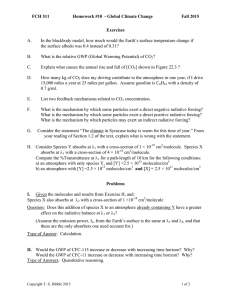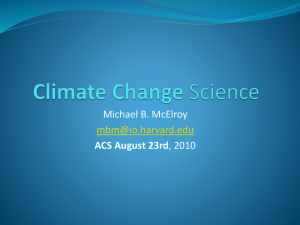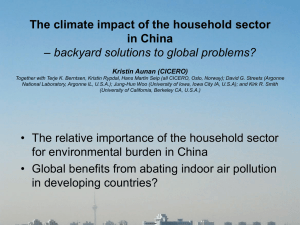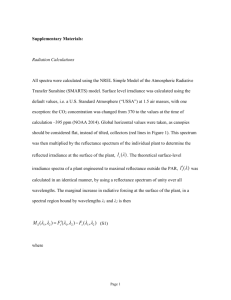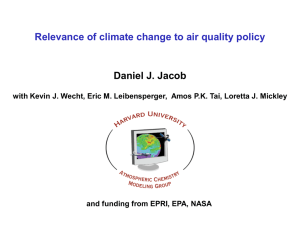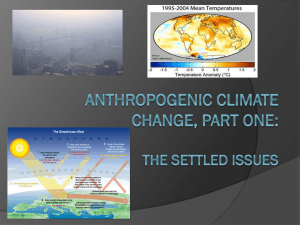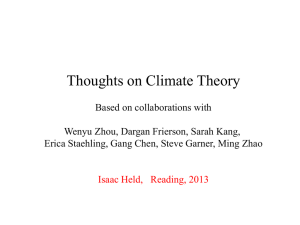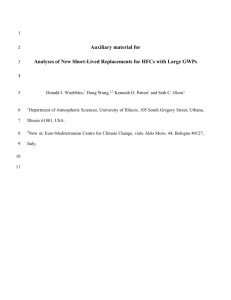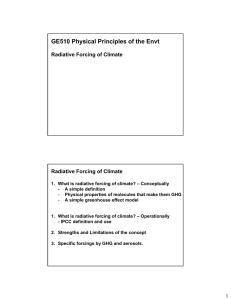Greenhouse effect indicators
advertisement
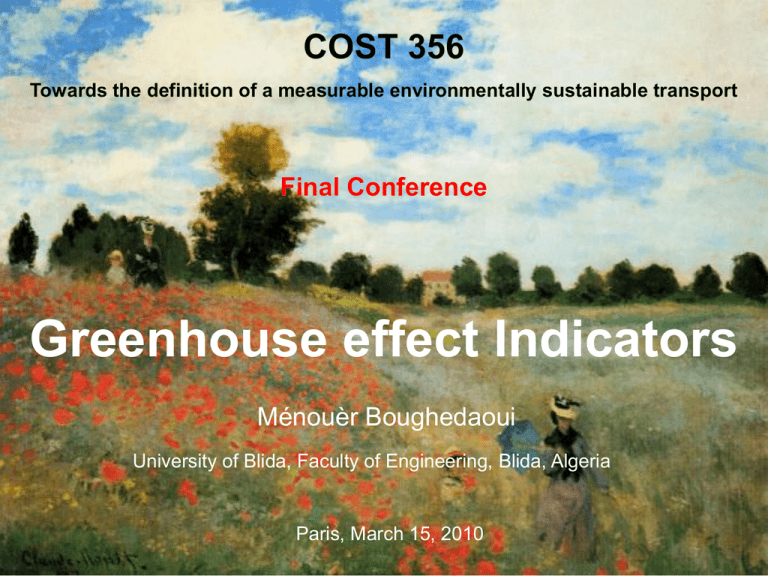
COST 356 Towards the definition of a measurable environmentally sustainable transport Final Conference Greenhouse effect Indicators Ménouèr Boughedaoui University of Blida, Faculty of Engineering, Blida, Algeria Paris, March 15, 2010 The greenhouse gas effect 1) Solar radiation 5 2 2) Reflected back to space 3) Absorbed by atmosphere 6 1 4) IR radiations emitted from Earth 5) IR escaped through atmosphere 4 3 6) Absorbed & re-emitted by GHG molecules The greenhouse gas effect • Changes in GHGs concentrations affect the absorption, scattering and emission of radiation within the atmosphere and at the Earth’s surface. • Atmospheric concentrations of GHGs increase when emissions are larger than removal processes. Cause-effect chain Emissions Region A Emissions Region B Emissions Region C Emissions Region D Driver Pressure State Concentrations Impact in Region A Driver Radiative forcing Impact Global average temperature change Impact Impact in Region B Impact in Region C Impact in Region D Impact Greenhouse effect indicators - Radiative Forcing: RF, RFI - Global Warming Potential: GWP - Global Temperature Change Potential: GTP - Carbon Equivalent Warming Number: CEWN - Impact on health Radiative forcing definition • Radiative forcing is a measure of the influence a factor has in altering the balance of incoming and outgoing energy in the Earth-atmosphere system. • Radiative forcing values are for changes relative to preindustrial conditions defined at 1750 and are expressed in watts per square metre (W/m2) UNFCCC need • The approach adopted in the UNFCCC and made operational in the Kyoto Protocol is a multi-gas abatement strategy. • Formulation of targets requires a metric whereby emissions of different gases with different atmospheric lifetimes and different radiative properties can be compared and weighted. Global Warming Potential • GWPs provide a metric for comparing the climatic impact of different greenhouse gases. T RF (t) dt g GWPg (T) 0 T RF CO 2 0 (t) dt Radiative forcing • RF which gives the change in radiative budget of the atmopshere system following a perturbation • GWP compares the integration of the RF of a pulse of emission of a GHG for specific time horizon CO2-equivalents Greenhouse Gases and Global Warming Gas Preindustrial Levels Current Levels Increase since 1750 Global warming potential (GWP) (over 100 yrs) Greenhouse Radiative Forcing (W/m2) Carbon Dioxide 280 ppm 387 ppm 104 ppm 1 1.46 Methane 700 ppb 1,745 ppb 1,045 ppb 25 0.48 Nitrous oxide 270 ppb 314 ppb 44 ppb 298 0.15 CFC-12 0 533 ppt 533 ppt >2000 0.17 Criticisms of GWPs • The impacts of two equal GWP-weighted emissions are equal only in terms of integrated radiative forcing over the chosen time horizon and not in terms of actual temperature change along the path or at the end of the time horizon. • The application of integrated radiative forcing may overestimate the effect of short-lived species if the goal of climate policies is to limit long-term temperature increase. Radiative Forcing Index • Radiative Forcing Index (RFI) is defined as the ratio of total radiative forcing to that from CO2 emissions alone. • Total radiative forcing induced by aircraft is the sum of all forcings, including direct changes in concentration (CO2, soot) and indirect atmospheric responses (CH4, O3, sulphate). Radiative Forcing Index • The RFI is designed to compare different sectors with respect to their impact on climate including their effects through nonCO2-gases. • The RFI allows a direct comparison of different sectors of fossil fuel use with respect to their total radiative impacts on the climate system (a comparison between road transport and aviation). Global temperature potential T GTP (t) T TH g H g H r Comparison of transport modes (Berntsen and Fuglestvedt, 2008) Carbon Equivalent Warming Number CEWN x CEWN x ACEWN xg ACEWN x CO 2 t xg 0 t xCO 2 0 Ag RFt dt' ACO 2 RFt CO 2 dt' GTP & CEWN • The GTP corresponds to a value after a given period of time has elapsed • The CEWN corresponds to an integrated value until a given removal rate has been reached Greenhouse effect impact on health Indicator GWPg Dref Dg GWPref Dg: damage due to the unit emission of the pollutant g (number of human life years when the health is affected) Using the Fund model for three gases: CH4, CO2, N2O Conclusions 1/2 • Metrics based on goals to be met (UNFCCC & KP) • GWP is an important tool for the implementation of the UNFCCC and the KP for a basket of the GHG (six gases) • GWP is mainly from a natural science perspective (social and economical) • Temperature change in a cost effective regime Conclusions 2/2 • GWP and Dp are quite well adapted to measure the impact of a policy action, but only when these actions impact the greenhouse gas emissions • GTPp can be used for a pulse emission change to estimate impact on temperature for short-lived species. • CEWN is less adapted to measure the action of a policy.
